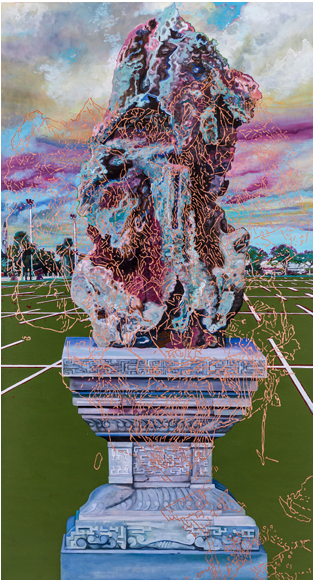
What Stones are Good For
This is artist Melissa Furness, and what you see in this area of the exhibition are a series of project-based pieces inspired by my experiences in China, Northern Ireland, and Mexico City. So I call this section of the exhibition What Stones Are Good For. As you can see me exploring stones in the forms of walls, a child's game, a scholar's meditation, and ancient ruins.
So these works are a response to observe piles of stuff, whether trash or stones, bread or artifacts, tragic folk narratives or expressions of gratitude. Each project piece is expressed as an action. Taking, breaking, skipping, shipping, standing piling and imprinting. While I'm in a location, I conduct time sensitive, somewhat performative process art pieces that directly address issues of place and culture. So this is an important aspect of my creative research as I seek to connect to a place as a different sort of tourist and other that is difficult to define, but which also allows one to observe, to respond to, and take part in a local community for a short time. So these thoughts and actions extend into more developed works that I explore with regards to the life of the art object.
So one project piece is one that I did and created while on site in Northern Ireland in conjunction with the pair of exhibitions through my involvement with the Artnauts Collective. I invite you to take a look at the video included here for more in depth information about this Breaking Bread project.
And then the second location that I have a relationship with is Beijing, China. I first visited there as a professor at China Agricultural University with whom UC Denver has a relationship, so after doing two trips as a professor, I decided to return to China as an artist in residence. I was struck by the difference between what the government represented of itself to me in the role of a professor in the main part of the city, versus what it was like as an artist in a local village. So the social services offered two different levels of society was something that struck me. So as an artist, I turned the corner of a major city to be confronted with dirt roads, trash, and animals about, people sitting around outside and socializing.
There was no way to contain trash, so it was all piled up in an organic way, like a beast that grew out of the ground until it was, once a week, scooped up by a tractor, and the whole process began again. I saw this pile as indicative of the life of a people showing their daily collective struggle. And so I decided to make a labored trumploy painting of this pile of trash to show its cultural significance.
All of this is a way of questioning what is chosen as significant or upheld as important to a culture versus what is chosen to be tossed or thrown out or thrown away and not shown to people. So with all these works, you can see me pushing the preciousness of painting. I cut paintings off of the stretchers, place them on the ground, build them into a ruinous structure or a stone circle, and let them weather outside. And so I am, you know, taking this established significant thing that you stand back and look at and removing this preciousness so that you consider it in a new way.
Another side project that I did while I was in China was one that I call "skipping stones". Skipping stones is an activity that people do around the world and is sometimes, you know, seen as a metaphor for life. You know, searching for the right stone and seeing how it can walk on water. I noticed that the city would start a public project and complete it up to a point and then just would stop, leaving the pile of bricks or stones there by the side of the road. So I decided to borrow a brick or stone from various unfinished public works, and brought them back to my studio to do this project where I wrapped them in linen and shipped them by sea back to the United States, like an epic game of skipping stones.
There was a lengthy dialogue with various confused postal workers and lugging of stones from taxi to taxi until they finally were shipped by sea, arriving to me in Denver four months later with one stone missing. I then reconstructed these linen strips into a museum esque artifact based off of research from the China National Museum.
So the stone circle that you see in the center of this space are depictions of scholar stones from China among the US suburban background spaces and metallic lines of trash piles with constructed wood to stand them up in the manner of the stone circle or billboard signs. So between them are cast iron trash sculptures with shiny beads and glitter. So these works continue the exploration of sight ruin and what is upheld as important versus what is discarded and thrown away.